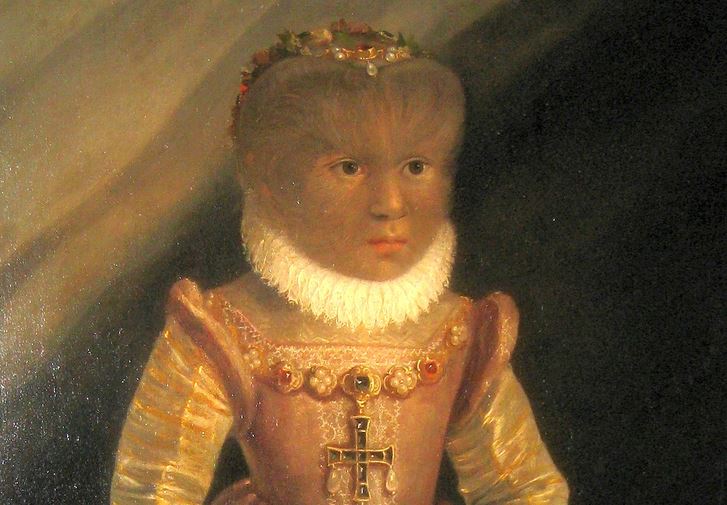Werewolf Fact #73 – Hypertrichosis, excessive hair growth (“werewolf syndrome”), Beauty and the Beast, and Bluebeard

You may have heard of “werewolf syndrome,” a condition of excessive hair growth. It isn’t to be confused with clinical lycanthropy, which is something else entirely. “Werewolf syndrome” is also called hypertrichosis – and it’s occasionally associated with and/or can even be derived from another condition, porphyria, that was also associated with “werewolves” throughout scholarship. Likewise, the most well-known kind of hypertrichosis that involves excessive hair growth all over the body is also often associated with gum and teeth problems; such issues could lead to unusual teeth and mouth shape.
Interestingly, however, despite a lot of modern scholars retroactively assuming that werewolf victims of the past could have suffered hypertrichosis, many of the werewolf legends in question specifically describe lycanthropy sufferers to look quite different. The legends in question are later era ones from the Early Modern period, during which time lycanthropy had become a madness and a disease under clinical and scientific supervision, very much unlike previous time periods, as I cover extensively in my book The Werewolf: Past and Future as well as other werewolf facts.
These legends describe sufferers of the werewolf curse variably to only be “hairy” when in their wolf form specifically (other than, occasionally, having long hair without mention of unusual body hair), highlighting how they were not unusually hairy in human form, or to “always [have] some hairs in the hollow of his hand” (as noted by Sabine Baring-Gould in The Book of Were-Wolves; taken from page 121 of my own edition of his work). Hypertrichosis often specifically does not have hair growth on the palms, conversely. Likewise, many legends of later time periods even specifically say that werewolves are not hairy “on the outside,” but that their hair “grows inward” when they aren’t in their inhuman form.
Still, scholars entertain the notion of connections that I still question to a healthy degree, so I have studied it as a result. I think it’s best to simply summarize it as, the syndrome reminds people of what werewolves are meant to look like, rather than asserting that “this is why some people believed in werewolves” and the like.
Hypertrichosis is rare, and any kind of proper documentation only began perhaps around the 1600s. During this time and for a very long time after, sufferers of hypertrichosis were often called a variety of terms like “ape-men” or “wolf-men.” They were considered spectacles and often were brought to noble courts like exotic animals, to entertain high society. Many were circus freaks. Not all examples are before our time, either.
But, Mav, you ask, how is this related to Beauty and the Beast and Bluebeard? Aren’t those fairytales?
One famous example of someone with hypertrichosis is the one whose related image began this post: Petrus Gonsalvus, who lived from around 1537 to sometime past 1617. He was called assorted names, such as “the wild gentleman of Tenerife,” “the man of the woods,” and of course, “the Canarian werewolf.” He lived in assorted courts throughout both Italy and France, including the court of Henry II, King of France, around 1547 – he was sent there when he was but 10 years old as a gift from a regent (Margaret of Parma) of the Netherlands. He moved about various courts over time and even married.
Much of Gonsalvus’s family inherited his condition (four of his seven children), including some of his daughters. Like their father, they were often traded amongst courts as pets of a sort. Here is Madelene Gonsalvus, a portrait from 1580:

It is believed that the marriage of Petrus Gonsalvus to his wife, a woman believed to be named Catherine and a lady-in-waiting to Catherine de Medici, may have provided some inspiration for the tale of Beauty and the Beast, which was first written in 1740 by Gabrielle-Suzanne Barbot de Villeneuve.
Beauty and the Beast may not be the only fairytale inspired by hypertrichosis, either. The tale of Bluebeard, as also discussed by Baring-Gould in his Book of Werewolves, describes Bluebeard as “His hair and moustache were light brown, and his beard was clipped to a point. This beard, which resembled no other beard” (232), similar to some elements of hypertrichosis variations, as well as mention of his gum condition: “At intervals he ground his teeth like a wild beast preparing to dash upon his prey, and then his lips became so contracted, as they were drawn in and glued, as it were, to his teeth, that their very colour was indiscernible” (233).
Sidebar: if you’re interested in the story of Bluebeard and what it was based on, definitely check out Sabine Baring-Gould’s The Book of Were-Wolves, as he has an unmatched documentation of it. I don’t think it really has a place in a book about werewolves, but obviously I preserved his work in its original condition, so you can find it in my edition of his book, as well. It’s not for the faint of heart, but it’s morbidly very interesting.
So, connection to werewolves or not, it’s still certain that hypertrichosis was seen as an inhuman condition. There are many examples of people who had or have the condition and records of how they were treated throughout history.
As mentioned, I have to wonder how much of this was actually associated with werewolf legends – given legends always explicitly involved transformation, which was the entire basis of it – but scholars eat this kind of thing up. In academia, everyone is always trying to come up with “new arguments” to “add to the conversation” or whatever, so we end up discussing and studying hypertrichosis alongside werewolf legends that specifically state such things weren’t a part of the legends. Weird, isn’t it?
Anyway, hope you enjoyed the post. Until next time!
And stay tuned for news and updates on a major [werewolf] book release later this year!